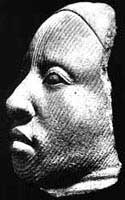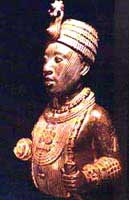
IFE DISCOVERY
 |
| 1 -
New York, Guennol Collection. Terracotta |

|
| 2 - Ife museum. Bronze |
Leo Frobenius (1873—1938), the German ethnologist, who made numerous expeditions to Africa, can lay claim to be the first European to spread the news of the existence of a high civilization in Nigeria, although he did not believe in its local origin. In November 1910, Frobenius arrived at Ile-Ife, the sacred city of the Yoruba, about which he had heard during his previous expeditions to West Africa. Re was particularly interested to learn about the image of the Yoruba god of seas and wealth, Ori Olokun, the equivalent of the Greek Poseidon and the Roman Neptune. On arrival, he set the local people to excavate in the sacred groves and within a few a weeks handsome collection of terracotta and stone sculptures was assembled, as well as the bronze Ori Olokun which he wanted so much to see.
Frobenius was astounded by the quality of the Ife sculptures; he observed that they were:
"eloquent of a symmetry, a vitality, a delicacy of form directly reminiscent of ancient Greece and proof that once upon a time, a race, far superior in strain to the Negro had settled here."
There are two points worth noting here. First, the quality of Ife sculptures was, in Frobenius opinion, comparable to Greek work, the envy of the European Renaissance. Secondly, he believed that the works were not of local origin. To this second point, we shall revert later.
Frobenius made one important observation which will have a great bearing on our discussion of the dating of Ife art. He observed that the places where the sculptures were buried were known to Ife people and that there was a practice of "resurrecting" the sculptures for use during festivals. Subsequent researches have confirmed that this has sometimes been the case.
At almost the same time as Frobenius published his findings, the British Museum published, in 1911, a photograph of a plaster cast of a fragment of a terracotta head (Fig. 1) which is now in the Brooklyn Museum, New York, U.S.A. It is still not known how the head left Nigeria.
In 1934, the present Oni of Ife, Sir Adesoji Aderemi, had some of the sculptures removed from the groves to his palace for safety. These, in addition to those which were already in his keeping, were eventually to form the nucleus of the Ife Museum. The need for a museum in Ife became more obvious when in 1938-39, at a short distance from the palace, in Wunmonije Compound, some exquisite bronze heads and a half figure (Fig. 2) all similar in style to the Ori Olokun, were accidentally dug up. Although the site was not studied by an archaeologist, it appears that the hoard formed part of a royal altar not unlike the present ancestral altar of the Oba (king) of Benin where art pieces are concentrated. William Fagg thought in 1953 that Wunmonije Compound could have been the real traditional burial place of the kings of Ife. It is important to note that many of the sculptures in Ife Museum were brought in as stray finds recovered by local people during work involving earth movement.
Ricerca Ing. F.P. Di Giacomo - Dati e cartografia in internet: Alpha Consult S.r.l - Web: G. Cerica |
|||